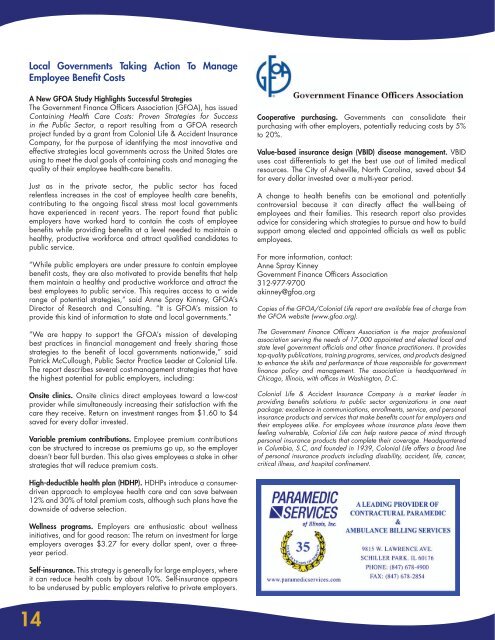December 2011 Newsletter.pdf - ILCMA
December 2011 Newsletter.pdf - ILCMA
December 2011 Newsletter.pdf - ILCMA
You also want an ePaper? Increase the reach of your titles
YUMPU automatically turns print PDFs into web optimized ePapers that Google loves.
Local Governments Taking Action To ManageEmployee Benefit CostsA New GFOA Study Highlights Successful StrategiesThe Government Finance Officers Association (GFOA), has issuedContaining Health Care Costs: Proven Strategies for Successin the Public Sector, a report resulting from a GFOA researchproject funded by a grant from Colonial Life & Accident InsuranceCompany, for the purpose of identifying the most innovative andeffective strategies local governments across the United States areusing to meet the dual goals of containing costs and managing thequality of their employee health-care benefits.Just as in the private sector, the public sector has facedrelentless increases in the cost of employee health care benefits,contributing to the ongoing fiscal stress most local governmentshave experienced in recent years. The report found that publicemployers have worked hard to contain the costs of employeebenefits while providing benefits at a level needed to maintain ahealthy, productive workforce and attract qualified candidates topublic service.“While public employers are under pressure to contain employeebenefit costs, they are also motivated to provide benefits that helpthem maintain a healthy and productive workforce and attract thebest employees to public service. This requires access to a widerange of potential strategies,” said Anne Spray Kinney, GFOA’sDirector of Research and Consulting. “It is GFOA’s mission toprovide this kind of information to state and local governments.”“We are happy to support the GFOA’s mission of developingbest practices in financial management and freely sharing thosestrategies to the benefit of local governments nationwide,” saidPatrick McCullough, Public Sector Practice Leader at Colonial Life.The report describes several cost-management strategies that havethe highest potential for public employers, including:Onsite clinics. Onsite clinics direct employees toward a low-costprovider while simultaneously increasing their satisfaction with thecare they receive. Return on investment ranges from $1.60 to $4saved for every dollar invested.Variable premium contributions. Employee premium contributionscan be structured to increase as premiums go up, so the employerdoesn’t bear full burden. This also gives employees a stake in otherstrategies that will reduce premium costs.Cooperative purchasing. Governments can consolidate theirpurchasing with other employers, potentially reducing costs by 5%to 20%.Value-based insurance design (VBID) disease management. VBIDuses cost differentials to get the best use out of limited medicalresources. The City of Asheville, North Carolina, saved about $4for every dollar invested over a multi-year period.A change to health benefits can be emotional and potentiallycontroversial because it can directly affect the well-being ofemployees and their families. This research report also providesadvice for considering which strategies to pursue and how to buildsupport among elected and appointed officials as well as publicemployees.For more information, contact:Anne Spray KinneyGovernment Finance Officers Association312-977-9700akinney@gfoa.orgCopies of the GFOA/Colonial Life report are available free of charge fromthe GFOA website (www.gfoa.org).The Government Finance Officers Association is the major professionalassociation serving the needs of 17,000 appointed and elected local andstate level government officials and other finance practitioners. It providestop-quality publications, training programs, services, and products designedto enhance the skills and performance of those responsible for governmentfinance policy and management. The association is headquartered inChicago, Illinois, with offices in Washington, D.C.Colonial Life & Accident Insurance Company is a market leader inproviding benefits solutions to public sector organizations in one neatpackage: excellence in communications, enrollments, service, and personalinsurance products and services that make benefits count for employers andtheir employees alike. For employees whose insurance plans leave themfeeling vulnerable, Colonial Life can help restore peace of mind throughpersonal insurance products that complete their coverage. Headquarteredin Columbia, S.C, and founded in 1939, Colonial Life offers a broad lineof personal insurance products including disability, accident, life, cancer,critical illness, and hospital confinement.High-deductible health plan (HDHP). HDHPs introduce a consumerdrivenapproach to employee health care and can save between12% and 30% of total premium costs, although such plans have thedownside of adverse selection.Wellness programs. Employers are enthusiastic about wellnessinitiatives, and for good reason: The return on investment for largeemployers averages $3.27 for every dollar spent, over a threeyearperiod.Self-insurance. This strategy is generally for large employers, whereit can reduce health costs by about 10%. Self-insurance appearsto be underused by public employers relative to private employers.14


